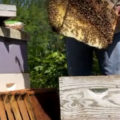I attended the Indiana Bee School XII in Indianapolis, Indiana on Saturday, February 22, 2014 with many of my fellow beekeepers. As usual, it was a great time… a full day of bee discussions and soaking up thousands of viewpoints. The attendance was a record. About 900 beekeepers were in attendance along with all our familiar vendors (Brushy Mountain, Kelley’s, Mann Lake, Blue Sky… and several others.) I had the pleasure of bartering some graphical services with an Amish vendor (King Bee) whom I met to pick up a bunch of woodenware. King Bee is located in Greencastle, IN and operated by a group of young Amish fellows. I enjoy talking to the Amish. It’s one of the things that keep me going back to the farmers markets each year. Their drive, work ethic, and professional appearance is both inspiring, and motivating. It is exciting to see how beekeeping is becoming more and more divers each year. It explains the record attendance at the conference, a 30% increase from last year.

As always, topics ranged from basic to advanced… and of course, in between all the factual stuff, you get a lot of varying perspectives on beekeeping. Taking notes, or recording the presentations for later review is important. It’s too much to dissect and absorb on the same day. Topics ranged from sustainable beekeeping, queen rearing/grafting, spring management, bee nutrition… and more.
I personally was there to soak up all I could on bee nutrition. Just like us humans, bees need a quality, and diverse diet if they are to be their healthiest, fittest self. How can we expect the bees to battle all the adversity in their world with sub-par health? Not only is the summer and fall in our area often difficult for our bees due to droughts and derths (derths are considered periods where the bees forage minimal pollen and nectar,) but land that is otherwise used by the bees is being diminished to make way for humans in a variety of ways. Add this to the pesticide and chemical movements, it’s cleat, to the bee, that the world is becoming a less-friendly place.
Nutrition, in my estimation is becoming more and more challenging not just in my area… but everywhere.. I have considered closing up some of my bee apiaries and finding new ones. I have some state conservationists coming out to look over some of my land to talk about the possibility of turning it into bee pasture. That’s all I’m going to say on this matter and I hope it inspires you to think about ways to turn areas… any area, into bee-friendly, or even wildlife-friendly space.

If we can address the nutritional needs of the honey bee, profound things can happen. Bees can fight off disease and virii more effectively. They can begin to challenge the varroa mite from taking over a colony, and they can find their fittest self to go out and forage, helping create a fuller honey supply. It pains me to think that when we fix one factor, it’s reduced by another. It is already a huge undertaking for the honey bee to fly out in search for a quality food supply. For that supply to be poisoned is heart-breaking. Corn and soy produce mediocre-quality nectar and pollen. The bees know the quality of their forage. If there is better forage nearby, they will go to it. However, if nothing else is found within the proximity of that colony, they will settle for the less-desireable supply. Only humans can help change this.
Many discussions included feed supplements to add to the hives. There were varying opinions on this, but everyone agreed that bee nutrition was a top priority. We have to be aware of the forage that is around our hives… and what kind of forage is available throughout the season. There are thousands of plant species that a bee can get pollen and nectar from, but in many areas, mine included, there are not enough species providing a quality, diverse, and most importantly a continuous supply. over the next year or two, I hope to help improve this within the proximity of my own bee hives. Imagine what could happen if each of us did a little to help that. Ask yourself what is within reason for you to do? If you do not know, ask someone. There are people at your state and local level that are happy to help… and they may even grant you some money to do so.

Another touchy topic is dealing with varroa mites. Most believe that a properly nourished bee is better suited to begin to deal with them, but differences of opinion surface when it comes to how to deal with mites in the meantime. How can bees find their fittest self when they are oppressed by the disease-spreading parasite called the varroa mite? There are two schools of thought when it comes to managing mites; Chemical treatments, or natural treatments? Up until now, I’ve never used a chemical treatment, but I’ve also lost my best hives after three years, despite the best effort I have put into them trying various “natural treatments” documented all over this website. We have covered powder-sugar dusting, reducing mite loads using timed rood-breaks, and the home-testing that typical beekeeper can do to measure and understand the mite loads in their hives. Just use the search mechanism at the top of the site to find them.
I enjoy being able to tell my customers that my honey comes from hives that have never contained chemicals. However, after understanding that the very foundation that I buy from the bee supply has trace amounts of chemicals in it as a result of them recycling the wax sold to them from larger beekeepers who do use chemicals, I am considering removing the chemical-free part, and explaining to the customers when asked. These trace amounts are just that… small, but Michael Bush will argue that it is enough to offset the natural balance of a bee colony. His solution is to allow the bees to draw all of their own comb and not use the contaminated foundation. I will be starting a couple “natural-cell” hives over the 2014 season to better see and understand this for myself. Michael Bush also has many years of practice and knowledge that has helped him arrive to where he is today. He also suggests that he has some great bee forage available to them… which I am sure makes a world of difference. Then, there are local guys like Tim Ives whose success runs contrary to the experience of many who do not use chemical treatments in their hives. Tim remains an inspiration to us as we push towards keeping bees naturally and removing the crutches that are often used to prop up the stability of our hives.

Along with my current “natural-treatment” apiaries, I am talking to some fellow beekeepers about setting up another testing apiary. We’re talking about calling it the “petri dish” where we will experiment with one of the many chemical treatments per year. The goal is to document some more solid facts and knowledge to bring to our bee meetings about its use… and results. Randy Oliver wrote a 12-part series on sick bees that make some compelling observations. All beekeepers who believe in good animal husbandry should read it. As I watch some of the new beekeepers that have set up hives last season going through their dead outs, I sympathize… and can relate because I have seen the same fate. We will be doing alcohol washes to test for mites in these deadouts so that we have definitive information about what happened to these hives. In our yards, mites are usually the prime culprit, and we’re determined to confirm it.
With each new beekeeper I speak to, there comes another nugget of information that needs to be considered and addressed. Dwight Wells tells us that it takes 4-5 years of beekeeping before one can really begin to understand enough about bees before they can make informed decisions about how they’ll change their practices in keeping bees. Should new beekeepers consider starting beekeeping using chemicals treatments to battle mites until they can become more informed about mites and their integrated propagation during the honeybee life-cycle and until they

understand more about bee physiology and genetics that seek to create a more durable bee? Afterall, these beekeepers can’t be beekeepers with dead bees each spring. Dead hives also offer no motivation to pick up the pieces and try again the next season. Do we not want more people eagerly taking up beekeeping and keeping at it?
What suggestions would you offer a friend who is considering beekeeping to prevent some of the pitfalls you have seen? Attending a local bee meeting, or even better, a program such as the IBA bee school is a good start in getting the information you need to begin beekeeping, or become an even better beekeeper. Each experience you have in the apiary should be meaningful, and memorable. In the end, it all adds up to knowledge. Knowledge is what is needed to provide a happier world for the bees and we need more people contributing in every way they can. Talk to us by leaving your comments! What are your thoughts? What works for you? Lend your comments below.





I cannot locate the Amish supplier King Bee that you reference in your IBA School article. Do you have an adress and phone number?
Thanks, Gregg
Sorry for the delay in response. The men are in fact Amish and so they don’t have a website. I’ve worked with Stevie King and the best way is to call toll free 844-KING-BEE and leave a message. He will return your call usually the same day, or a day later. I brought home several of his whole hives and am very impressed with the quality. It’s Amish! Take care.